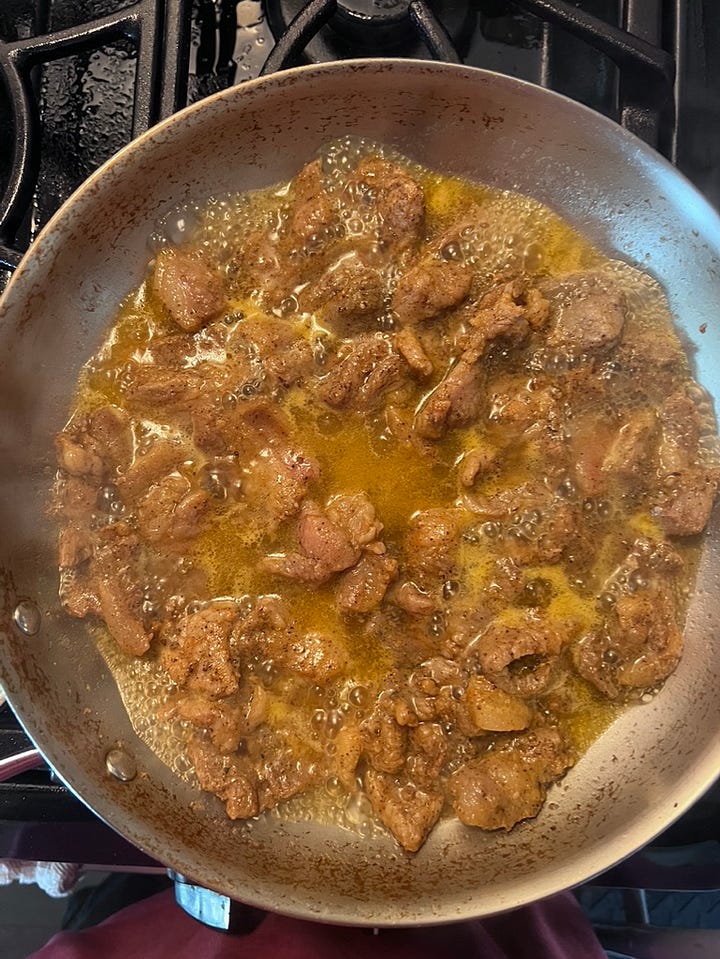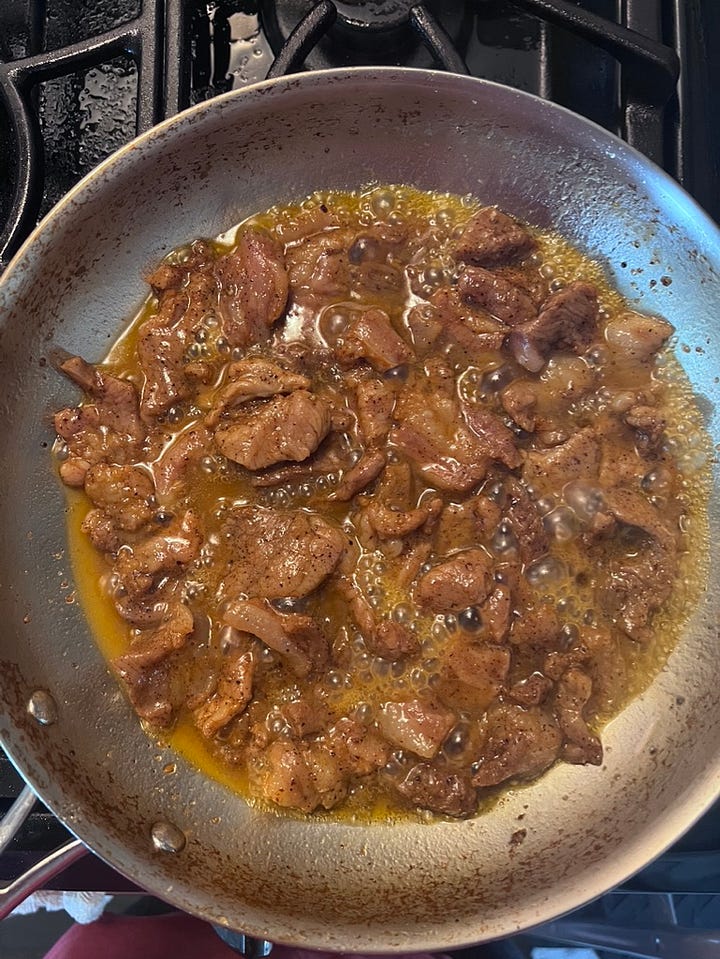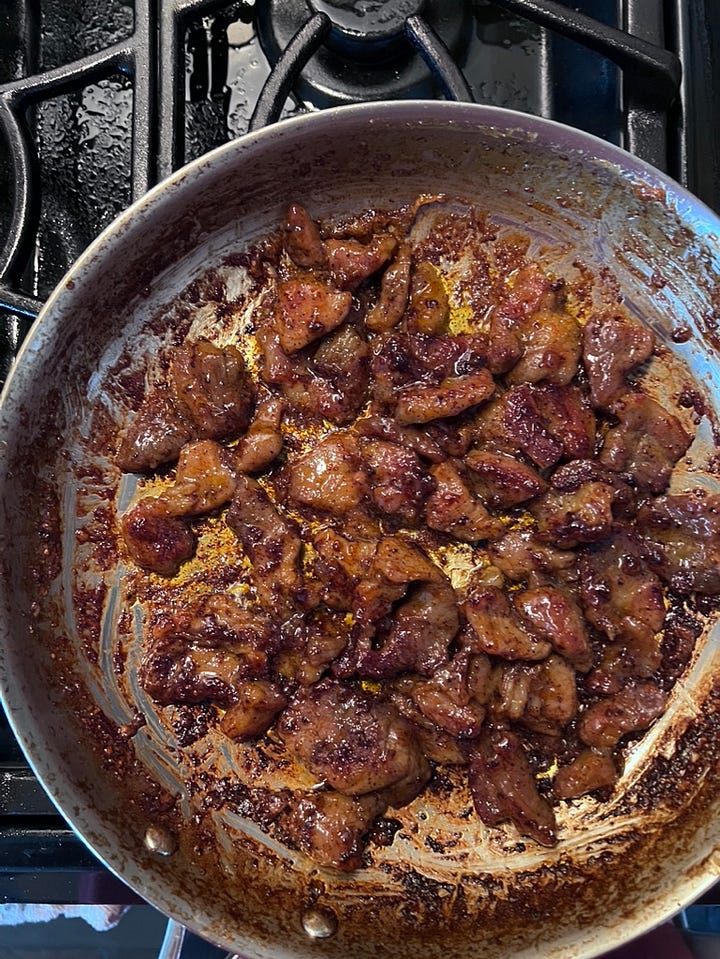A Filipino Breakfast Part II: Pork Tocino
This week I’m taking you back to the Philippines for another hearty breakfast of silog, featuring garlic fried rice and eggs. This time we’re going to make tocilog, completing our meal with pork tocino, one of my absolute favorite Filipino meat dishes. It’s made of thinly sliced pork shoulder that’s cured in a spice mix for 3-4 days before pan frying. It’s a little more effort than the beef tapa we made last week, and requires sourcing a couple ingredients you may not have on hand. That said, it’s absolutely worth it in my opinion. Try the beef tapa first if you haven’t yet, and if you love it as much as I think you will, give this pork tocino a shot next.
You can refer back to last week’s post for recipes for sinangang (garlic fried rice), itlog (fried egg), and beef tapa. Let’s dive into our pork tocino!
Pork Tocino
Makes 8 servings (¼ lb each)
This recipe uses a very similar technique to beef tapa for cooking on the stovetop, but it’s flavored with a cure of salt, sugar, and spices rather than a liquid marinade. The cure takes a few days, so it requires a bit more planning, and it has a couple ingredients you may not just have lying around. Once you have those ingredients it’s quite simple to prepare though.
It’s pretty hard to find a pork shoulder that’s less than 2 pounds, so I’ve written this recipe for a 2 pound cut. If you can find a smaller cut, by all means scale this recipe down for 2 or 4. More likely you’ll only be able to find something even bigger. Luckily, this recipe will scale up to whatever size pork shoulder you have, and it freezes well too. Just portion out everything you don’t intend to cook right away into ziploc freezer bags after the curing step is done, then thaw a portion out in the fridge the day before you want to cook it up for breakfast.




Ingredients
1/3 cup granulated sugar
1/3 cup brown sugar
2 Tbsp kosher salt
2 tsp annatto powder
1 tsp Anisette (or other Anise-flavored liquor)
2 pounds pork shoulder
2 Tbsp neutral cooking oil (canola, grapeseed, etc), for frying
¼ cup water, or more as needed
Method
Prepare the cure. Combine the sugars, salt, annatto powder, and anise in a bowl and stir with a whisk to combine.
You may be able to find annatto powder in a store, but I usually order whole seeds online and then grind some up in an old blade coffee grinder I keep around for grinding spices. No need to buy a special spice grinder if you have one of those! It’s best to have a separate one for spices so you don’t flavor your coffee by accident, but you can also grind up some white rice in it after each use which will help clean and deodorize it.
The traditional way to add a hint of anise flavor to the cure is to use Anisado wine, but I have no idea where to find that, so I’ve always used a substitute. Joshua Bousel over at Serious Eats suggests using Anisette in his recipe. I’ve used St George Absinthe Verte, and I’ve also tried grinding up just a little bit of anise seed and used that along with a splash of cane vinegar. A little anise goes a long way though so whatever you use, be cautious with the amount, and if you’re not really into its licorice-like flavor you can just skip this altogether.
Traditionally, pork tocino was cured for much longer periods and used potassium nitrate, or saltpeter, as a preservative, which would give the meat a distinctive red color. This isn’t required for a shorter cure like ours, but you’ll find a lot of tocino recipes calling for either a small amount of pink curing salt or even red food coloring to reproduce the visual effect. I don’t find the red color particularly appealing, so I always skip this bit.
Cure the pork. Slice the pork shoulder thinly into pieces a couple inches long and about ¼ inch thick, and add it to a container with a lid that you can keep in the fridge. Add the cure to the container, mix well with the meat, cover, and put in the fridge for 3-4 days.
There’s nothing wrong with having some pretty fatty slices, but if you’ve got a big fat cap on your pork shoulder, go ahead and trim most of it off. You can even use that to make pork cracklings and lard if you like. Waste not, want not!
A good thing to have around the kitchen is a big box of food-safe disposable gloves for activities that are best to do with your hands like smooshing a cure into a big pile of raw pork.
Braise the pork. Take the pork out of the fridge a half hour before you’re going to fry it up so it can get to room temperature. Pour all the tocino with its marinade into a pan on the stovetop over medium heat. Spread the pork evenly throughout the pan, and add 2 Tbsp of neutral oil and enough water to almost cover the pork slices. Braise the pork, stirring occasionally, until the water reduces completely.
Caramelize the pork. Once the water reduces, the sugars and meat will start to caramelize and brown in the remaining oil. Keep a close eye on it from here on out, stirring constantly to prevent burning, and lowering the heat if needed. It’s done when the pork is glazed with the almost-fully-reduced sauce and nicely browned. Serve immediately with garlic rice and fried eggs, and garnish with crispy garlic.

That’s all there is to it, I know you’ll be as big a fan of Filipino breakfasts as we are once you give these tasty silogs a try!


